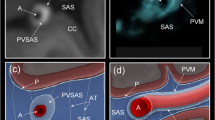Summary
After suboccipital injection of Iotrol and Iopamidol labelled with iodine 125 in rabbits, we measured residual radioactivity in the whole brain and optical density on autoradiographs of brain sections obtained 2, 8 and 24 h after injection. Residual radioactivity is higher with Iotrol than with Iopamidol after 8 h and 24 h. At densitometry, while the penetration of the cortex is the same with both media at 2 h (although subcortical passage of Iotrol is greater), by 8 h the concentration of Iopamidol is twice that of Iotrol, and at 24 h it is three times as high. A similar pattern was seen in the subcortical region. These densitometric findings are in agreement with previous electrophysiological studies, in which changes were less severe and more transient with Iotrol than with Iohexol. There is nevertheless and apparent lack of agreement between the studies of radioactivity and the electrical findings. The lower neurotoxicity of Iotrol may be explained by: 1, a longer half-life in the subarachnoid space; 2. its larger molecules, which inhibit diffusion in the extracellular fluid, and 3. its more hydrophilic nature, which reduces intracellular penetration.
Similar content being viewed by others
References
(1973) Acta Radiol Suppl 355. Metrizamide a non-ionic water-soluble contrast medium. Stockholm
Caille JM, Guibert-Tranier F, Howa JM, Billerey J, Calabet A, Piton J (1980) Contamination encéphalique par le métrizamide après myélographie. J Neuroradiol 7:3–12
Caille JM, Gioux M, Arne P, Paty J (1983) Neurotoxicity of nonionic iodinated water soluble contrast media in myelography: experimental study. AJNR 4:1185–1189
Carlborg B, Maly P, Golman K, Almen T, Linquist C (1982) Changes in the cerebro-spinal fluid pressure after intrathecal injection of contrast media in rabbits. In: Amiel M (ed) Contrast media in radiology, Springer, Berlin pp 159–163
Drayer BP, Rosenbaum AE (1977) Metrizamide brain penetrance. Acta radiol [Suppl] 355:280–293
Golman K, Dahl SG (1973) Absorption of labelled metrizamide, diatrizoate, inulin and water from cerebrospinal fluid to blood. A pharmacokinetic investigation in cats with normal and impaired renal function. Acta Radiol [suppl] 355:276–283
Gonsette RE (1982) The neurotoxicity of water-soluble contrast media: actual concepts and future. In: Amiel M (ed) Contrast media in radiology. Springer, Berlin pp 115–122
Hershkowitz W, Bryan MR (1981) Intracellular effects of radiographic contrast agents. The American Society of Neuroradiology, Chicago, 4–10 April
Mutzel W (1987) Research rapport of Schering by Mutzel (in press)
Pitre D, Felder E (1980) Development chemistry and physical properties of Iopamidol and its analogs. Invest Radiol 15:301–308
Rosenbaum AE, Drayer BP (1977) CT cisternography with metrizamide. Acta radiol [suppl] 355:323–377
Sackett JF, Strother CM (1977) CT and subarachnoid metrizamide for evaluation of cerebrospinal fluid flow. Acta radiol [suppl] 355:338–344
Sage MR, Wilcox J (1983) Brain parenchyma penetration by intrathecal nonionic Iopamidol. AJNR 1181–1183
Sovak M, Rangomathan H, Hammer B (1984) Early experience with Iotrol, a non ionic isotonic dimer for intrathecal space. Invest Radiol 19:4
Stanley I, Rapaport MD (1976) Blood brain barrier in physiology and medicine. Raven Press, New York
Cserr HF, Fenstermacher JD, Ferrel V (1975) Fluid environnement of the Brain. Academic Press
Author information
Authors and Affiliations
Rights and permissions
About this article
Cite this article
Castel, JC., Dorcier, F. & Caillé, J.M. Penetration of the brain by nonionic water soluble tri-and hexaiodinated contrast media. Neuroradiology 29, 206–210 (1987). https://doi.org/10.1007/BF00327552
Received:
Issue Date:
DOI: https://doi.org/10.1007/BF00327552




